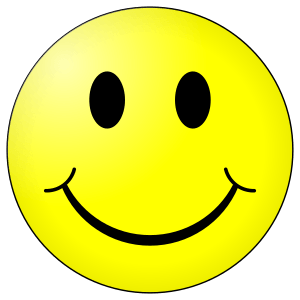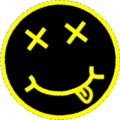Smiley facts for kids
A smiley is a picture of a smiling face. It helps us show feelings without using words. People also call it a "smiley face" or an "emoticon." The first popular smileys were yellow buttons. Today, most smileys are made with computer keyboard symbols. Many people use them in emails and other online messages.
Contents
The History of Smileys
The First Smiley Button
Simple smiling faces have been drawn for a long time. They often had a circle with two dots for eyes and a curved line for a mouth. The most famous smiley face was made in 1963. A man named Harvey Ball designed it for an insurance company. It was a bright yellow circle with black oval eyes and a big, curved mouth. It even had little creases at the ends of the smile.
This design became very popular in the early 1970s. Two brothers, Murray and Bernard Spain, sold many items with the smiley face. They put it on buttons, coffee mugs, t-shirts, and bumper stickers. They also used the saying "Have a happy day." Smiley buttons were a huge hit from the 1970s onwards.
Smileyworld: A Happier Brand
Smiley is a brand that started in 1971 by Franklin Loufrani. He runs a company called Smileyworld Ltd. Their goal is to make the world a happier place. The Smiley brand is sold all over the world. It appears on many different products. The company's designers are always creating new and cool items.
Smileyworld Ltd gives ten percent of its earnings to a charity. This charity is called the Smiley World Association. It helps people in need in many countries. Their motto is "Share your smile with those in need."
In 1997, Franklin's son, Nicolas Loufrani, started something new. He created many new icons based on the original Smiley logo. Now, there are over 1200 icons used as part of the Smileyworld brand. This brand helps people communicate better. It offers things like greeting cards and gifts. It also has educational items like books and toys.
Smiley and the Law
The Smiley name and logo have been officially protected since 1971. They are registered in over 100 countries. This means no one else can use them without permission. More than 1200 Smiley emoticons are also protected by copyright. Over the past 10 years, Smileyworld Ltd has made many agreements. They work with law firms to protect their designs around the world.
Emoticons: Digital Smileys
In the 1990s, the internet and emails became very popular. People wanted an easy way to show feelings in their messages. So, they started making small smiling faces using keyboard symbols. These are called emoticons.
A common keyboard smiley uses a colon ":" for the eyes. It has a hyphen "-" for the nose. And a parenthesis ")" for the mouth. Some people leave out the hyphen. These "smileys" look sideways.
Here is an example of a smiley:
- :-)
If you tilt your head to the left, it looks like a happy face!
Emoticons are usually part of a written message. Sometimes, a smiley is sent alone to say "I'm happy with your last message." Emoticons are great for showing feelings. They help when you can't see the person's face.
- A smiley often shows happiness: "I bought a new computer today! :-)"
- It can show you don't want to upset someone: "That was a silly thing to do! :-)"
- A smiley can also show you are joking or being sarcastic: "Don't you think tests in school are really fun? :-)"
Other emoticons were created from the basic smiley to show different feelings:
- :-) ... Happy
- ;-) ... Winking (like a secret joke)
- :-D ... Very happy or laughing
- x-D ... Laughing hard
- :-( ... Frowning or sad
- :-| ... Disappointed
- :-o ... Surprised
- :'( ... Crying
- :-s ... Worried
- {:-o ... Going crazy
- :-P ... Sticking your tongue out
- x-P ... That's gross!
- <:o) ... Let's party!
People sometimes use different symbols or leave out the nose.
Images for kids
-
The Nirvana band's smiley logo.
See also
 In Spanish: Smiley para niños
In Spanish: Smiley para niños




